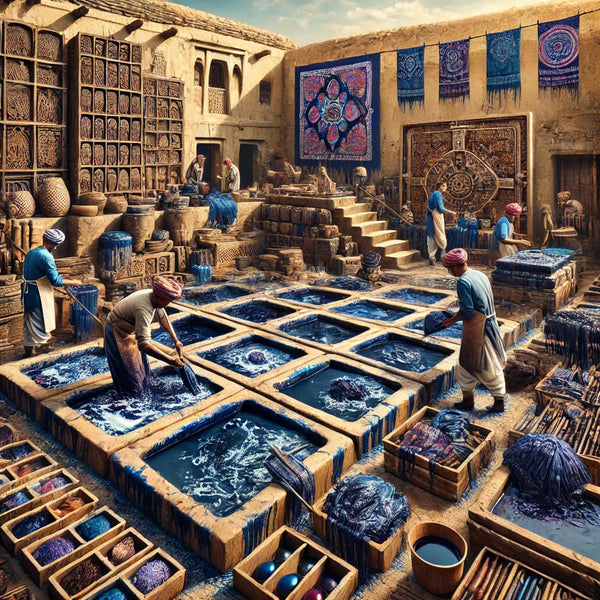The deep, mesmerizing blue of indigo has fascinated civilizations for centuries. Among the many places that mastered this natural dyeing technique, Gujarat stands out as a historical and cultural hub of indigo dyeing in India. Rooted in tradition and sustainability, Gujarat’s indigo dyeing methods date back to ancient times, flourishing under the skilled hands of artisans who have preserved this heritage for generations.
At Vasudhaa Vastrram, we take immense pride in reviving and promoting such traditional crafts through our sustainable men’s wear collection. Our commitment to organic dyeing and eco-friendly processes ensures that each garment reflects this rich heritage while being mindful of nature.
The Origins of Indigo in Gujarat
Indigo, derived from the plant Indigofera tinctoria, has been cultivated in India for thousands of years. Historical records suggest that the ancient Harappan civilization used indigo for dyeing textiles as early as 2500 BCE. Gujarat, with its rich textile traditions and strategic location along trade routes, became a prominent center for indigo production and dyeing. The region’s climatic conditions and soil made it an ideal place for growing indigo plants, and local artisans perfected the art of extracting and using the dye.
The Traditional Indigo Dyeing Process
The indigo dyeing technique of Gujarat is a meticulous and time-honored process that requires skill and patience. Unlike synthetic dyes, natural indigo does not dissolve in water. The process involves several steps:
- Extraction of Indigo: Leaves of the indigo plant are harvested and soaked in water for fermentation. This process releases the blue pigment, which settles at the bottom and is later dried into cakes or powder.
- Preparation of the Dye Vat: The dried indigo pigment is mixed with natural ingredients such as lime, sugar, and tamarind seed powder to create a dye bath. This fermentation-based process produces the necessary chemical reaction to make the indigo water-soluble.
- Dyeing the Fabric: The fabric, often cotton or silk, is immersed in the dye bath multiple times. Each dip deepens the shade of blue. Interestingly, indigo appears green when the fabric is first removed from the vat but turns blue as it oxidizes in the air.
- Final Washing and Sun Drying: After achieving the desired color, the fabric is washed to remove excess dye and dried in the sun, allowing the vibrant blue hues to develop fully.
Famous Indigo-Dyed Textiles of Gujarat
Several traditional textile crafts of Gujarat incorporate the indigo dyeing technique:
- Ajrakh Printing: Practiced by the Khatri community in Kutch, Ajrakh is a block-printing technique that uses natural dyes, including indigo, to create intricate geometric and floral patterns.
- Bandhani (Tie-Dye): A traditional resist-dyeing method where fabrics are tied in patterns before being dipped into indigo dye, resulting in beautiful dot designs.
- Mashru Fabric: A blend of cotton and silk, Mashru is often dyed in rich shades of indigo, creating stunning striped and solid textiles.
Sustainability and Revival of Indigo Dyeing
Indigo dyeing in Gujarat is an eco-friendly process that aligns with the principles of sustainable fashion. Unlike synthetic dyes, natural indigo does not produce harmful chemical waste. Many artisans and brands are working to revive this ancient craft, ensuring its survival in the modern textile industry. Sustainable initiatives are promoting hand-dyed indigo textiles, supporting local artisans, and preserving Gujarat’s rich heritage.
At Vasudhaa Vastrram, we integrate these traditional techniques into our collections, ensuring that every piece is crafted with authenticity and sustainability in mind. Our organically dyed indigo garments are a tribute to this age-old practice, offering a timeless appeal with an eco-conscious approach.
Conclusion
The ancient indigo dyeing technique of Gujarat is more than just a craft—it is a symbol of India’s deep-rooted textile legacy. The rich blue hues, achieved through painstaking efforts and traditional knowledge, continue to inspire contemporary fashion and sustainable textile movements worldwide. As we embrace eco-conscious choices, supporting Gujarat’s indigo artisans is a step toward preserving a time-honored craft and celebrating the beauty of natural dyes.
Explore our indigo-dyed collection at Vasudhaa Vastrram and experience the magic of heritage, sustainability, and craftsmanship. Each piece tells a story—woven in tradition, dyed in nature, and crafted for the future.






